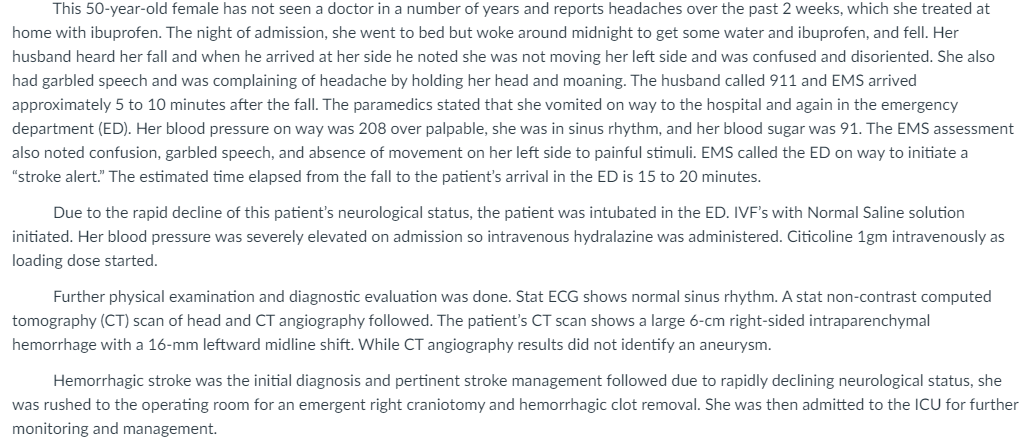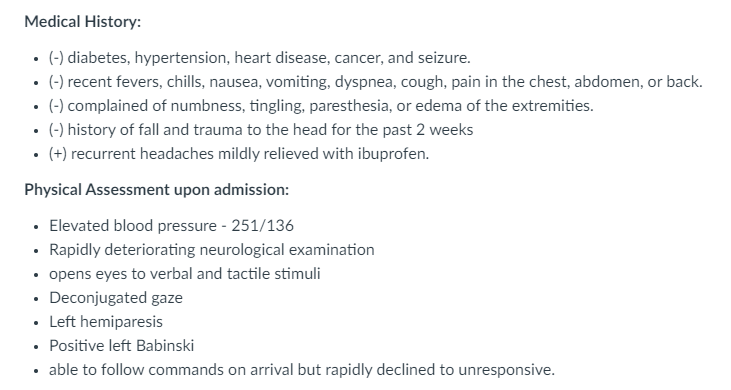A. Create 2 nursing care plans based on the case scenario that needs to be prioritized using ADPIE. A-ssessment, D-iagnosis, P-lanning/Goal, Interventions with Rationale, and E-valuation
A. Create 2 nursing care plans based on the case scenario that needs to be prioritized using ADPIE. A-ssessment, D-iagnosis, P-lanning/Goal, Interventions with Rationale, and E-valuation
Medical Terminology for Health Professions, Spiral bound Version (MindTap Course List)
8th Edition
ISBN:9781305634350
Author:Ann Ehrlich, Carol L. Schroeder, Laura Ehrlich, Katrina A. Schroeder
Publisher:Ann Ehrlich, Carol L. Schroeder, Laura Ehrlich, Katrina A. Schroeder
Chapter4: The Muscular System
Section: Chapter Questions
Problem 70LE: Carolyn Goodwin complained of profound fatigue that is not improved by bed rest and was made worse...
Related questions
Question
A. Create 2 nursing care plans based on the case scenario that needs to be prioritized using ADPIE.
- A-ssessment, D-iagnosis, P-lanning/Goal, Interventions with Rationale, and E-valuation

Transcribed Image Text:This 50-year-old female has not seen a doctor in a number of years and reports headaches over the past 2 weeks, which she treated at
home with ibuprofen. The night of admission, she went to bed but woke around midnight to get some water and ibuprofen, and fell. Her
husband heard her fall and when he arrived at her side he noted she was not moving her left side and was confused and disoriented. She also
had garbled speech and was complaining of headache by holding her head and moaning. The husband called 911 and EMS arrived
approximately 5 to 10 minutes after the fall. The paramedics stated that she vomited on way to the hospital and again in the emergency
department (ED). Her blood pressure on way was 208 over palpable, she was in sinus rhythm, and her blood sugar was 91. The EMS assessment
also noted confusion, garbled speech, and absence of movement on her left side to painful stimuli. EMS called the ED on way to initiate a
"stroke alert." The estimated time elapsed from the fall to the patient's arrival in the ED is 15 to 20 minutes.
Due to the rapid decline of this patient's neurological status, the patient was intubated in the ED. IVF's with Normal Saline solution
initiated. Her blood pressure was severely elevated on admission so intravenous hydralazine was administered. Citicoline 1gm intravenously as
loading dose started.
Further physical examination and diagnostic evaluation was done. Stat ECG shows normal sinus rhythm. A stat non-contrast computed
tomography (CT) scan of head and CT angiography followed. The patient's CT scan shows a large 6-cm right-sided intraparenchymal
hemorrhage with a 16-mm leftward midline shift. While CT angiography results did not identify an aneurysm.
Hemorrhagic stroke was the initial diagnosis and pertinent stroke management followed due to rapidly declining neurological status, she
was rushed to the operating room for an emergent right craniotomy and hemorrhagic clot removal. She was then admitted to the ICU for further
monitoring and management.

Transcribed Image Text:Medical History:
• (-) diabetes, hypertension, heart disease, cancer, and seizure.
• (-) recent fevers, chills, nausea, vomiting, dyspnea, cough, pain in the chest, abdomen, or back.
(-) complained of numbness, tingling, paresthesia, or edema of the extremities.
• (-) history of fall and trauma to the head for the past 2 weeks
• (+) recurrent headaches mildly relieved with ibuprofen.
Physical Assessment upon admission:
• Elevated blood pressure - 251/136
• Rapidly deteriorating neurological examination
• opens eyes to verbal and tactile stimuli
• Deconjugated gaze
• Left hemiparesis
• Positive left Babinski
• able to follow commands on arrival but rapidly declined to unresponsive.
Expert Solution
This question has been solved!
Explore an expertly crafted, step-by-step solution for a thorough understanding of key concepts.
Step by step
Solved in 2 steps

Recommended textbooks for you

Medical Terminology for Health Professions, Spira…
Health & Nutrition
ISBN:
9781305634350
Author:
Ann Ehrlich, Carol L. Schroeder, Laura Ehrlich, Katrina A. Schroeder
Publisher:
Cengage Learning


Medical Terminology for Health Professions, Spira…
Health & Nutrition
ISBN:
9781305634350
Author:
Ann Ehrlich, Carol L. Schroeder, Laura Ehrlich, Katrina A. Schroeder
Publisher:
Cengage Learning
